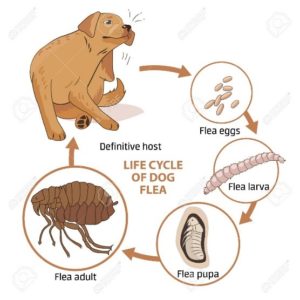As most pet owners are aware, flea infestations are quite a nuisance. They are capable of causing a range of problems to both pets and pet owners, so keeping them under control is a definitely a necessity. This article will briefly explore the problems fleas can cause, the fleas lifecycle, and methods of prevention.
The Problems They Cause
Irritation – Fleas have sucking mouthparts which are inserted into the skin for them to feed on blood and their saliva contains anticoagulants to keep blood flowing to the bite site. The action of the mouthpart insertion and anticoagulant chemicals leads to itching and irritation.
Dermatitis – Some pets will develop an allergic reaction to the flea bite which can lead to skin conditions such as flea bite dermatitis.
Anemia – Anemia means a below normal count of red blood cells. If exposed to severe infestations the feeding fleas can significantly reduce red blood cell counts which can lead to a range of health issues.
Parasite Introduction – Fleas are capable of transmitting other parasites to your pet such as tapeworm.
Flea Lifecycle
 Adult flea on dog feeds, mates and lays eggs which drop off to environment.
Adult flea on dog feeds, mates and lays eggs which drop off to environment.
- Eggs hatch to larvae which live in carpets, bedding, and dusty areas such as under a house.
- Larvae develop into pupae (cocoon) in the environment and an adult flea develops inside. This stage can lay dormant for long periods of time.
- Adult flea emerges and finds another host.
Principles of Prevention
- Treat the Fleas on Your Pet- This is very important as it breaks the flea’s lifecycle by killing the adults so that no further production of eggs can occur. There are a wide range of products that are available on the market for treating fleas including spot-ons, tablets and chews. For dogs we recommend Nexguard, which is a flavoured chew given monthly that also controls ticks. Please Note: Never give a cat a treatment intended for dogs.
- Treat All Pets in the Area- If your dog is treated with a preventative medication but your cat isn’t, fleas will continue their lifecycle by only feeding on your cat and no real progress will be made in ridding them from your home. So remember that all animals in living in the area must be treated.
- Control the Environment- When your pet is first treated and the adult fleas on him/her drop off and die just remember the other stages of the lifecycle which remain and are still developing in the environment. These stages will eventually develop into fleas and expose themselves to your pet and only then will they be vulnerable to the treatment. With minor infestations flea numbers will gradually drop until there are no more in the environment. Bad infestations however may require other measures such as blocking off your pets access to under the house or dusty areas, frequent washing of pet bedding, and regular vacuuming of carpet in the house. Just be sure to stick to these principles and in the end you will emerge the flea-free and victorious!